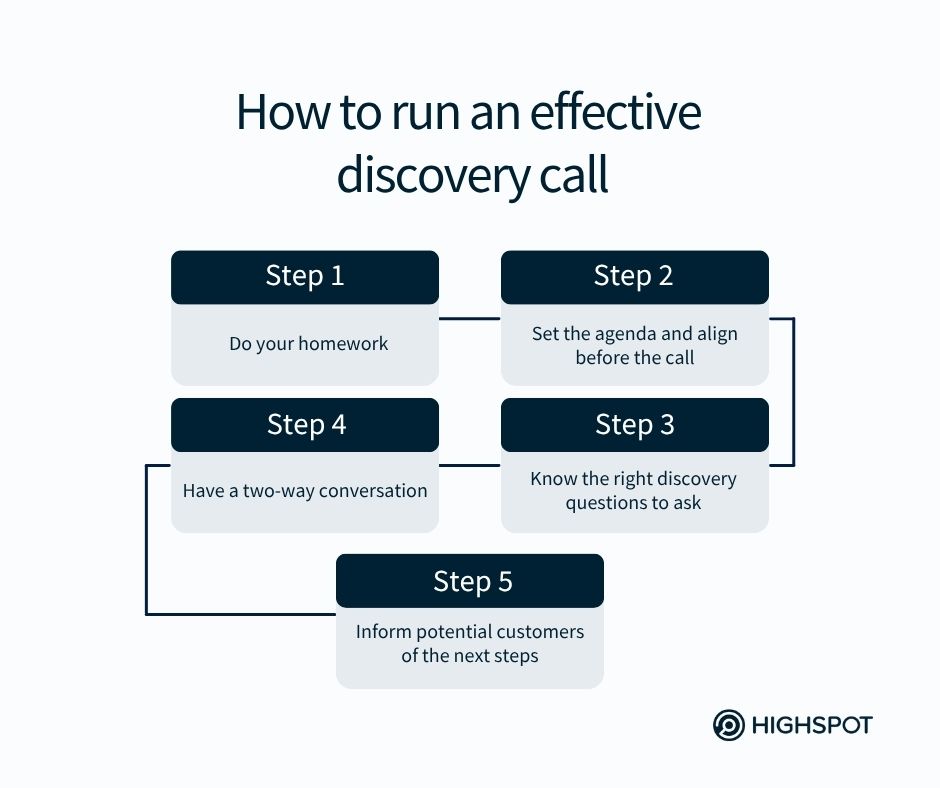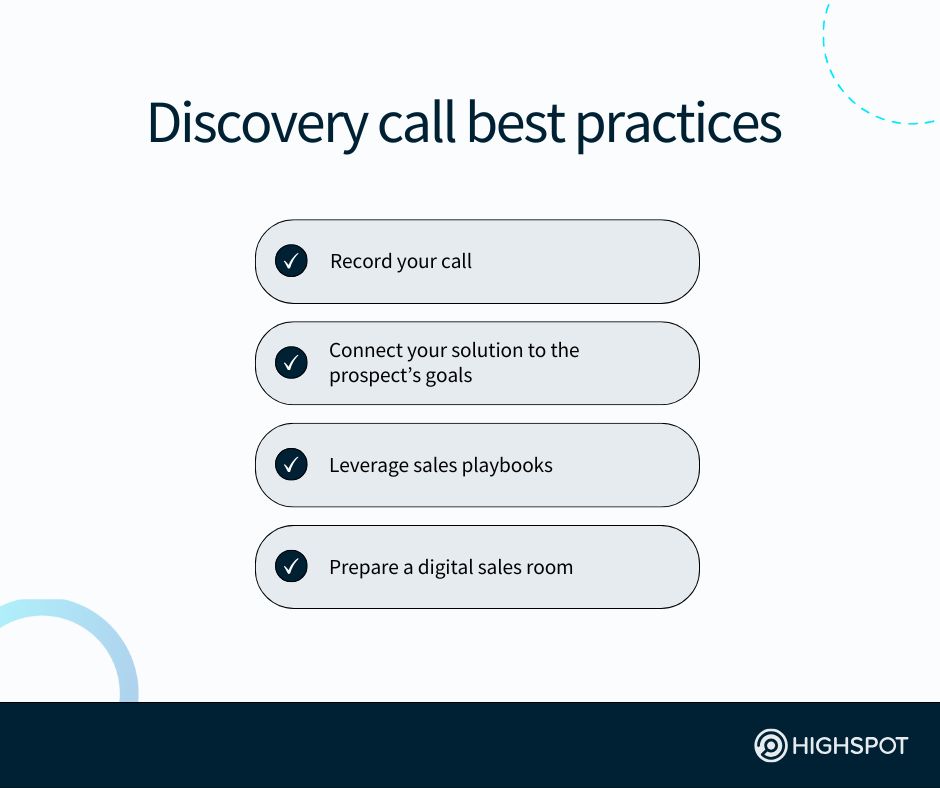Key Takeaways
- A discovery call is the first conversation between a sales rep and potential customer who has expressed initial interest or buying intent regarding a company’s products or services.
- Discovery calls are important for assessing fit and pain points: from a buyer’s scope and budget, to their urgency and key stakeholders. Asking key qualification questions around these areas is critical to nailing this early part of the sales process.
- Leveraging tools like sales playbooks, digital sales rooms, and conversation intelligence and AI-powered enablement capabilities can simplify the complexities of discovery calls.
All great customer relationships start with an effective discovery call.
When executed well, discovery calls offer reps such as yourself a perfect way to set the tone for deal discussions with high-value prospects in their sales pipeline.
Not only does asking leads relevant and timely discovery questions ensure alignment with their buying needs, but it also speeds up the decision-making process.
“Each discovery call and successive conversation has forged a shared history between you and your prospect,” Highspot’s Fast-Flowing Sales Pipeline guide explains. “You know their limitations, pain points, and goals for the future. If you’ve been listening carefully, you have the blueprint for success.
Asking pertinent, open-ended questions before diving into your sales pitch is essential in these chats with prospects. However, there are a number of other best practices you and other reps at your company must abide by to continually improve the effectiveness of your sales discovery calls—and, in turn, close more deals.
What is a discovery call?
A sales discovery call is an initial interaction between a sales rep and a potential client or customer who has shown interest in a company and one or more of its products or services.
This initial conversation uncovers buying decision-makers’ wants, needs, objectives, and challenges and allows reps to relay the key benefits and value of their organisation’s offerings.
The goal is to establish a relationship with the lead, qualify if they’re a good fit, understand how your business solution can help solve their specific problems they have, and—if they’re qualified—advance them through your sales pipeline.
The difference between a discovery call and a cold call
A discovery call happens once a prospect has shown some level of interest, such as filling out a form, downloading content, or attending a webinar. It’s a more focused conversation designed to explore the individual’s goals and pain points, like moving off a legacy technology or realising some form of cost savings.
A cold call, on the other hand, is an unsolicited outreach to yet-to-be-engaged leads.
Cold calling focuses on pitching a solution proactively to prospects who haven’t shown any explicit interest but who make sense to target, since they align with your organisation’s ideal customer profile (ICP) and buyer personas. (That is, they have a similar business to those of existing customers.)
Here’s a detailed comparison between the two:
| Discovery call | Cold call | |
|---|---|---|
| Timing | After a prospect has shown interest | First unsolicited outreach to a lead |
| Purpose | Qualify leads who match ICP and assess fit | Generate interest and book a meeting |
| Buyer intent | Medium to high | Low or unknown |
| Personalisation | Higher—based on prior signals, contact forms, or sales engagement | Minimal—often based on basic research |
| Length | 15-30 minutes | 1-5 minutes |
| Goal | Understand their needs, build rapport, and decide on next steps (keep the conversation flowing or move on to other client leads) | Convert the prospect into a paying/loyal customer by identifying issues promptly and pitching a solution as the ideal outcome |
Why are discovery calls important?
The sales discovery call is usually the first time a qualified lead—one who has declared clear interest in your organisation’s offerings in some direct and clear manner—will speak to you or another rep to begin the sales process in earnest.
This is your chance to deeply understand a given prospect’s pain points and business needs and determine if they constitute a ‘real’ sales opportunity worth pursuing today to capitalise on their perceived buying intent and momentum.
When you qualify prospects early on, you save valuable time and resources. (What’s more, you avoid potentially missing opportunities who could become high-value customers.)
An organised, thoughtful discovery call also lays the foundation for strong, consultative relationships. By tailoring the sales conversation to the buyer’s objectives and challenges, you can build trust and increase your chances of closing the deal.
When done right, a discovery call reveals the ‘Job to Be Done’ a lead needs solved and whether their leadership team is also invested in change and investment.
And, when leveraging a go-to-market (GTM) enablement platform with powerful AI and rich analytics, you can leverage discovery call insights to plan future interactions (and sales content to share with prospects) more intelligently.

How to run an effective discovery call
The same way to plan for other customer engagement activities later on in your sales cycle, the discovery process requires research, planning, commitment, and timely follow-up. These calls allow your sales reps to begin a potentially lucrative relationship by understanding the lead and their aspirations.
Here’s how to lead the conversation with purpose, ensure you know the right questions to ask, and make the most of the time you have with leads on discovery calls.
1. Do your homework
Spend time researching your prospect, their company, and their industry. The goal is simple: Show up informed so you can ask better questions and get to the point faster.
Start with:
- LinkedIn: Check their role, tenure, accomplishments, background, and recent activity, like posts they’ve published. Look out for any mutual connections as well.
- Company website: Investigate their products, services, leadership, and any recent brand news that may prove applicable to any conversations you have with them.
- Industry updates: Discover the latest trends and challenges their company might be facing, based on the state of their sector and what’s impacting business success.
Then, ask yourself:
- Are they an influencer or a procurement decision-maker?
- What might their goals or KPIs look like, based on their role?
- What specific problems might they care about the most?
This ensures a more focused, productive discussion.
2. Set the agenda and align before the call
Make scheduling easy by offering prospects a few time slots or booking link to put time on your calendar. Once confirmed, send an invite with a clear agenda to ensure you and your lead are on the same page. Keep it simple:
- Include 2-3 key discussion points.
- Offer a clear takeaway for the buyer.
- Send a reminder to avoid no-shows.
Leave a few minutes at the end of each discovery call to align on next steps.
3. Know the right discovery questions to ask
Databox research found the conversion rate from discovery calls to sales is about 10-30%. This emphasises how crucial it is to ask only the most appropriate questions.
Develop a list of the most relevant discovery call questions to encourage the prospect to openly talk about their business. These should explore their day-to-day processes.
Ask enough questions (this will vary by lead) that generate insights you need without overwhelming your prospect. Some essential discovery questions to ask include:
- Could you share a brief overview of your company and the focus of your business?
- What are your primary responsibilities, and what does a typical day look like?
- What specific goals are you aiming to achieve in the short term and long term?
- What are your biggest challenges, and how do they impact day-to-day operations?
- What’s your approximate budget for this initiative, and when do you plan to buy?
- What is your timeline for implementation, and when do you need to see results?
- What does a successful outcome look like to you in both the near and long term?
Space out your questions to keep the conversation moving along and respectful of the prospect’s time. The most successful discovery calls are ones where you let you leads — well — take the lead, and you interject with relevant questions based on their responses and the flow of your discussion.
Pro tip: Consider applying the SPIN selling methodology (situation, problem, implication, need-payoff) to focus on your prospect’s needs rather than your product. This will help guide the call with situation questions before problem questions.
4. Have a two-way conversation
Prepare to speak 50% of the time and encourage the lead to share their thoughts for the remainder of your calls. The more natural the conversation feels, the more your prospect is likely to open up and feel at ease. This builds trust and rapport.
Some other tips:
- Always ask open-ended questions instead of yes/no questions, to avoid stagnant conversations and creating ‘dead air’ during deal discussions.
- Practice active listening. This means paying close attention to every word, paraphrasing key points, and asking thoughtful follow-up questions.
- Acknowledge prospects’ pain points when they come up. A quick, “That sounds frustrating,” shows empathy and that you truly care about their needs.
The goal is to learn—not pitch. It’ll become easier to tie in your solution to your prospect’s business needs once you understand their world better following chats.
5. Inform potential customers of the next steps
After discussing their business needs and how your product can help, outline the next steps. Whether scheduling another call, sending additional information, or arranging a demo, ensure that the prospect knows what to expect.
Discovery call script example
No two discovery calls are the same. That said, the discovery call script below can act as a guide to help you prepare for initial conversations with leads.
(Note: Cutting-edge AI sales role play tools can also help your entire sales team practice these back-and-forth discussions so you can test out questions, pacing, tone, objection-handling, and other elements of typical discovery calls.)
Sales Rep: Hi [Prospect’s Name], this is [Your Name] from [Your Company]. How are you today? I hope I’m catching you at a good time.
Prospect: [Response]
Sales Rep: Thanks for chatting! I’d love to address any questions and hear more about your business goals. If we find a good fit, we can schedule a time with one of our account executives. If it’s not the right match, no hard feelings at all. Sound good?
Prospect: [Response]
Sales Rep: Just out of curiosity, what brought you to us? Was it something like our recent whitepaper, one of our demos, or maybe a webinar you attended?
Prospect: [Response]
Sales Rep: Interesting, thanks for sharing that. Can you tell me about some of the business issues you’ve been running into lately?
Prospect: [Describes problems]
Sales Rep: I see. That sounds challenging. Will you go into a little more detail for me? How long has this been going on? What solutions have you already tried, and how did those work out? Also, how big of an issue is this for your team, and why is tackling it now so important?
Prospect: [Provides details]
Sales Rep: It sounds like you have some tools and processes in place. What’s stopping you from continuing to leverage those resources to address your issues?
Prospect: [Provides details]
Sales Rep: Thanks for opening up about that—it sounds like these are pressing issues. We are just about out of time, but I think it’s worth looking at how we can help. I would be a terrible salesperson if I didn’t lock in a time to really get into the nitty-gritty?
Prospect: [Provides details]
Sales Rep (if prospect is hesitant or unsure): No worries at all. I appreciate your honesty today. Who else on your team is part of this initiative? What’s happening in their world that makes this a priority? Can you think of anything that would prevent them from moving forward?
Sales Rep (if prospect is interested): Fantastic! Do you have your calendar handy? Let’s schedule a detailed discussion with our account executive next week—it usually takes about an hour. What day works best for you? I’ll send a calendar invite and a summary of our discussion today. If there’s anything not right, feel free to let me know. Does this plan work for you?
Prospect: [Response]
Sales Rep: Great, [Prospect’s Name]. Thanks again for your time today and for sharing your story. I am looking forward to our next steps. Enjoy the rest of your day!

Discovery call best practices
Sales discovery calls can make or break your deal. But winging it doesn’t cut it, especially if you’re selling into competitive markets or complex industries. Here’s how to conduct this call like an expert every time:
Record your call
Consider using sales enablement platforms that offer conversational intelligence, call recording, transcription, and pattern-detection capabilities. This software helps you review calls, pinpoint areas for improvement, and detect conversation patterns.
Recording calls ensures you don’t miss details and provides coaching opportunities, as well as a reference to better personalise your follow-up call.
Leverage sales playbooks
A well-built sales playbook gives you a repeatable structure for different types of discovery calls, so you’re not starting from scratch every time. Specifically, look for playbooks that help you:
- Adapt to different personas
- Navigate industry-specific needs
- Handle objections from key stakeholders
- Follow proven talk tracks (but stay flexible as needed)
If your company doesn’t have a formal playbook, create a lightweight one. Document what’s working in your sales calls, and tap into the analytics in your go-to-market team’s tech stack, like those offered in your CRM and enablement solution.
Connect your solution to the prospect’s goals
While the primary goal of a discovery call is to listen, prepare to share relevant insights and communicate your product’s value proposition when appropriate.
As you learn more about their company’s goals and challenges, tailor your message to show how your solution can support what they’re trying to achieve. Share quick examples of how you’ve helped others in their industry facing similar challenges.
If there’s time and interest, consider showing a quick demo toward the end of the call.
Prepare a digital sales room
Once you’ve had your discovery call, centralise all info and outreach in a digital sales room where your buyer can access important documents and personalised content that will move them through the sales cycle and set the stage for the next call you might have in the days, weeks, and months ahead.
“Utilising personalised messaging, content, and digital sales rooms helps surpass prospect expectations and deliver a superior experience,” according to Highspot’s What Good Client Engagement Looks Like guide.
How to plan your follow-up call with leads after a successful discovery call
Follow-up will help maintain momentum after the discovery call is over. It keeps the prospect moving through the sales funnel. Here’s how you can best optimise the discovery follow-up process to accelerate deal velocity:
Send an email immediately afterwards
Prompt follow-ups keep your product top of mind. Seth Marrs, VP, Principal Analyst of Forrester, stresses that “buyers expect sellers to be responsive and answer questions in a timely manner.”
Consider conversational intelligence tools to streamline this process. These tools summarise call details and automate email drafts with next steps, enabling swift responses that cover all critical points without added human effort.
Build a custom-tailored product demo
Work with sales engineering to configure a product demo based on the specific issues discussed during the discovery call. This demonstration should focus on how your solution addresses the prospect’s unique challenges, showcasing your understanding of their needs.
Analyse each call using AI to improve
Analysing your calls helps identify what works and what doesn’t. Some sales training platforms with enablement capabilities come with AI-powered tools that suggest coaching opportunities and ways to streamline workflows.
Turn great discovery calls into sales opportunities
A great discovery call can make the rest of the sales process smoother. It’s your chance to build meaningful relationships and figure out if the opportunity is worth pursuing.
This isn’t about racing through a question list. It’s about having a productive conversation. It’s important to give your prospect space to talk about what matters most to them.
When your discovery calls are intentional, focused, and buyer-led, the results speak for themselves.




